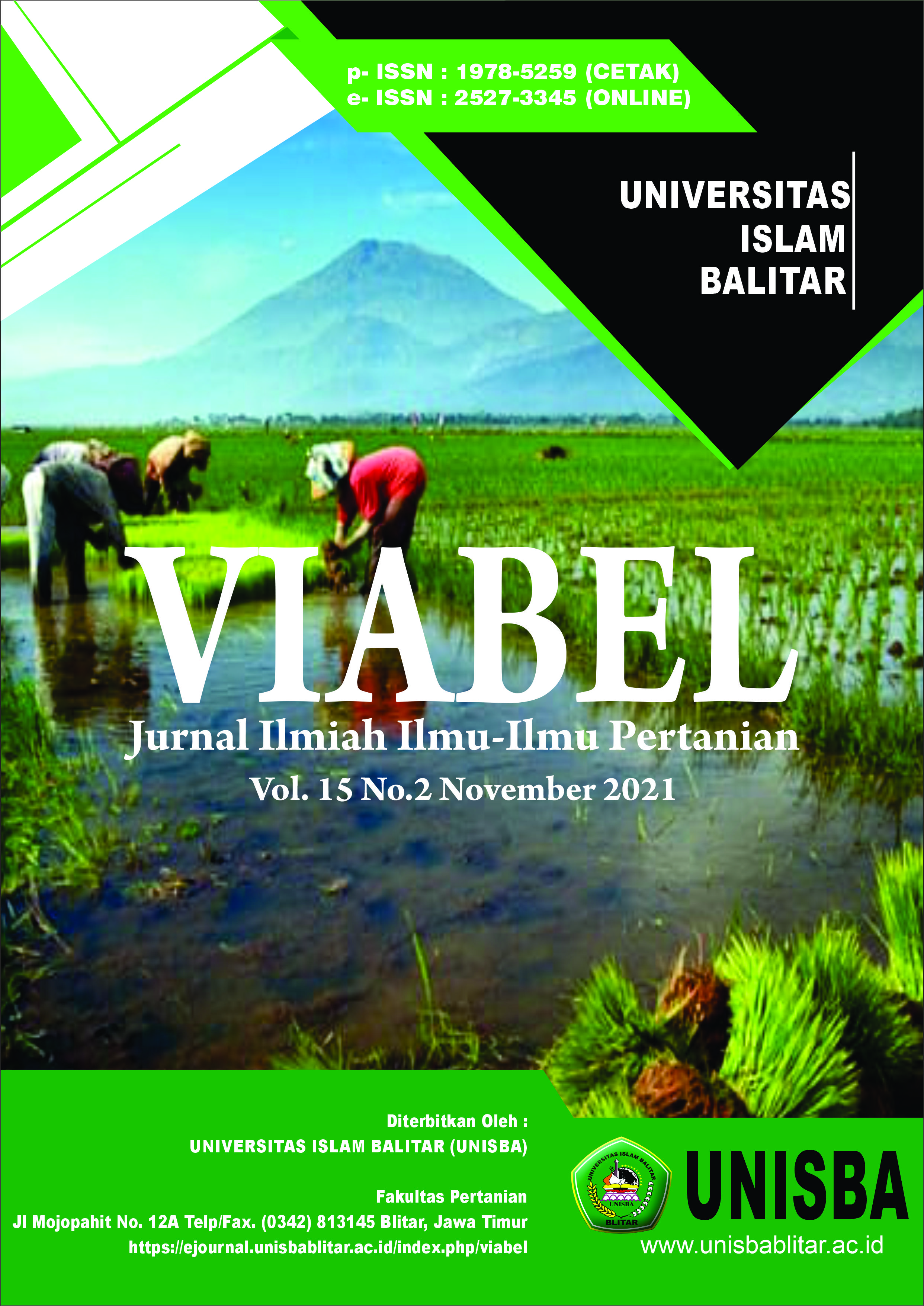AQUAPONIK SOLUSI URBAN FARMING
AQUAPONIK SOLUSI URBAN FARMING DI PERUM PANDANWANGI GREEN MALANG
DOI:
https://doi.org/10.35457/viabel.v15i2.1635Keywords:
Aquaponic, Vegetable and Fish Consumption, Income SavingAbstract
Urban farming is one of the strategies that can shape family food security in urban areas. The aquaponic system is one of the urban farming activities. Small-scale aquaponics can be used for household scale. Maximum care is needed in aquaponic cultivation so that the growth and yield of vegetables and fish are good. Aquaponic can be an IRT solution that does not manage daily food expenditure by getting fish and vegetable crops that are harvested per day. The purpose of this community service is to: (1) analyze the frequency of household vegetable consumption, (2) analyze household income (savings) from the application of aquaponics. This study uses a qualitative approach and survey methods and uses income analysis. The results showed: (1) There was an increase in the frequency of eating vegetables in respondents by 9.5%. Before the socialization, the frequency of eating vegetables for households was 90.5%, while after the activity was carried out, the frequency of eating vegetables was 100%. Respondents consume vegetables every day so that they have fulfilled the minimum amount of vegetable and fruit consumption per household member is three portions of fruit and two portions of vegetables or vice versa every day (2) Household food income or saving by applying aquaculture is Rp. 126.000/month obtained from the harvest of vegetables and catfish.
Downloads
References
Anindya, D. A.M., Putri, D.N., & Priambodo, N. D. (2021). Efektivitas program kawasan rumah pangan lestari (krpl) dalam mendukung ketahanan pangan rumah tangga selama pandemi di kota kediri. AGRISAINTIFIKA: JURNAL ILMU-ILMU PERTANIAN, 5 (1), 8–17. DOI: https://doi.org/10.32585/ags.v5i1.1278
Efendi, E. (2016). Efektifitas Sistem Akuaponik Dalam. November 2014.
Firdaus, M. R., Hasan, Z., Gumilar, I., & Subhan, U. (2018). Efektivitas Berbagai Media Tanam Untuk Mengurangi Karbon Organik Total Pada Sistem Akuaponik Dengan Tanaman Selada. Jurnal Perikanan Dan Kelautan Vol., IX(1), 35–48.
Haloho, R. D., Santoso, S. I., Marzuki, S., Roessali, W., & Setiadi, A. (2013). Profit function analysis of dairy cattle farming in getasan and west ungaran districts, semarang regency. Journal of the Indonesian Tropical Animal Agriculture, 38(2), 116–122. https://doi.org/10.14710/jitaa.38.2.116-122
Handayani, L. (2018). Pemanfaatan Lahan Sempit Dengan Sistem. Prosiding Seminar Nasional Hasil Pengabdian 2018, 118–126.
Handayani, S. A., Irwan, E., & Begem, V. (2017). Produksi dan Pendapatan Usahatani Padi di Desa Pujo Asri Kecamatan Trimurjo Kabupaten Lampung Tengah. Jiia, 5(4), 422–429.
Li, C., Lee, C. T., Gao, Y., Hashim, H., Zhang, X., Wu, W. M., & Zhang, Z. (2018). Prospect of aquaponics for the sustainable development of food production in urban. Chemical Engineering Transactions, 63, 475–480. https://doi.org/10.3303/CET1863080
Purwantini, Tri., S., & Suharyono, S. (2016). Program Kawasan Rumah Pangan Lestari (KRPL) di Kabupaten Pacitan: Analisis Dampak dan Antisipasi ke Depan. Analisis Kebijakan Pertanian, 10(3), 239. https://doi.org/10.21082/akp.v10n3.2012.239-256
Rizal, A., Dhahiyat, Y., Zahidah, Andriani, Y., Handaka, A. A., & Sahidin, A. (2018). The economic and social benefits of an aquaponic system for the integrated production of fish and water plants. IOP Conference Series: Earth and Environmental Science, 137(1). https://doi.org/10.1088/1755-1315/137/1/012098
Saidah, Z., Harianto, H., Hartoyo, S., & Asmarantaka, R. W. (2019). Transaction Cost Analysis on Revenues and Profits of Red Chili Farming. Jurnal Manajemen Dan Agribisnis, 16(1), 66–76. https://doi.org/10.17358/jma.16.1.66
Septia, E. D., Windiana, L., & Amir, N. O. (2018). Pemberdayaan Ibu Rumah Tangga Dengan Teknologi Budidaya Aquavertikulture Pada Lahan Sempit. CARADDE: Jurnal Pengabdian Kepada Masyarakat, 1(1), 30–35. https://doi.org/10.31960/caradde.v1i1.17
Shafahi, M., & Woolston, D. (2014). Aquaponics: A Sustainable Food Production System. November 2014. https://doi.org/10.1115/imece2014-39441
Taqwdasbriliani, ertris bergas, Hutabarat, J., & Arini, E. (2013). Journal of Aquaculture Management and Technology Journal of Aquaculture Management and Technology. Journal of Aquaculture Management and Technology, 2(3), 76–85. http://ejournal-s1.undip.ac.id/index.php/jfpik
Windiana, L., & Artha, D. (2019). Kontribusi Usaha Tani Bunga Krisan Potong Terhadap Pendapatan Petani Di Desa Sidomulyo Kota Batu Jawa Timur. Agriecobis: Journal of Agricultural Socioeconomics and Business, 1(1).
Downloads
Published
Issue
Section
License
Copyright (c) 2021 VIABEL: Jurnal Ilmiah Ilmu-Ilmu Pertanian

This work is licensed under a Creative Commons Attribution-ShareAlike 4.0 International License.
Authors who publish with this journal agree to the following terms:
- Copyright on any article is retained by the author(s).
- The author grants the journal, right of first publication with the work simultaneously licensed under a Creative Commons Attribution License that allows others to share the work with an acknowledgment of the work’s authorship and initial publication in this journal.
- Authors are able to enter into separate, additional contractual arrangements for the non-exclusive distribution of the journal’s published version of the work (e.g., post it to an institutional repository or publish it in a book), with an acknowledgment of its initial publication in this journal.
- Authors are permitted and encouraged to post their work online (e.g., in institutional repositories or on their website) prior to and during the submission process, as it can lead to productive exchanges, as well as earlier and greater citation of published work.
- The article and any associated published material is distributed under the Creative Commons Attribution-ShareAlike 4.0 International License










.png)




